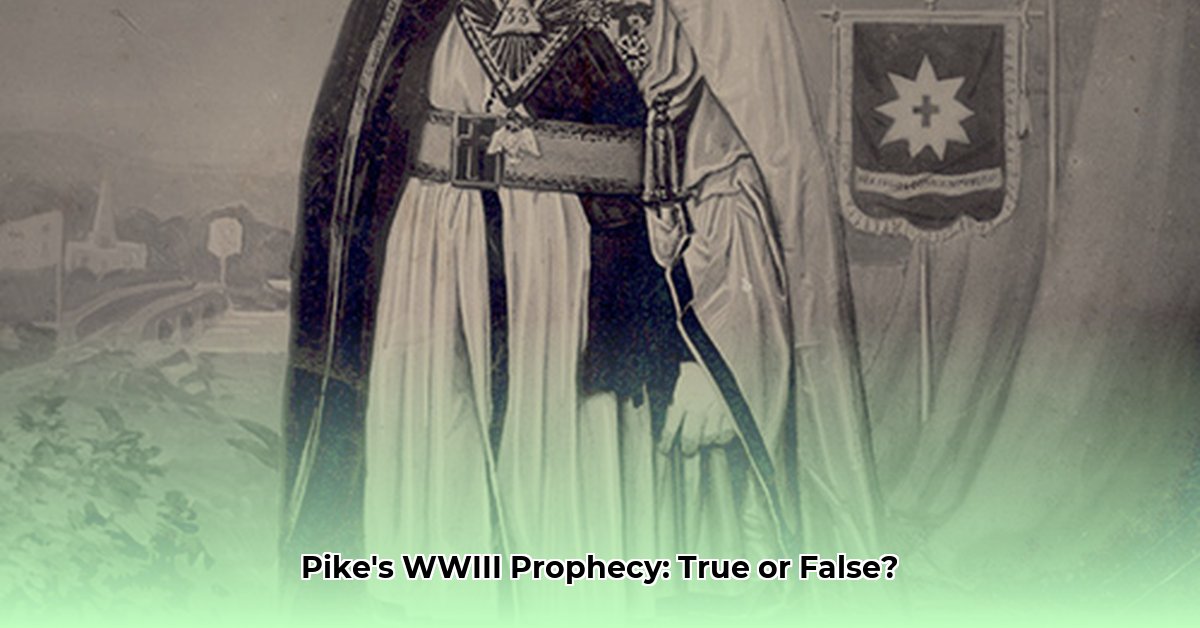This article examines the persistent “Albert Pike World War 3” prophecy, a theory claiming the 19th-century Freemason predicted three global conflicts. Through rigorous analysis, we’ll debunk this myth and explore why such narratives gain traction.
Debunking Pike’s Alleged Predictions
The “Albert Pike World War 3” prophecy alleges that Pike, a Confederate general and Freemason, foretold three world wars in a letter to Italian revolutionary Giuseppe Mazzini. The supposed letter details meticulously planned wars, orchestrated by shadowy secret societies to establish a “New World Order.” This dramatic narrative has captivated many, but how much truth does it hold? The answer, based on available evidence, is none.
Pike: The Man, Not the Myth
Albert Pike (1809-1891) was a complex figure. A Confederate general, lawyer, writer, and prominent Freemason, his interests revolved around Masonic rituals, symbolism, and philosophy—not global domination or predicting wars. His extensive writings, particularly Morals and Dogma, delve into esoteric Masonic philosophy, not blueprints for international political manipulation.
The Non-Existent Letter
The crux of the prophecy is the alleged letter to Mazzini. This letter, supposedly residing in the British Library, details the three-phase plan for global conflict. However, the British Library has explicitly denied possessing such a document. This crucial piece of “evidence” is simply non-existent.
William Guy Carr’s Pawns in the Game (1958) is often cited as a source for the prophecy. However, even Carr admitted difficulty verifying the letter’s authenticity. The prophecy’s origins likely lie in the obscure, anti-Semitic publication The Mystery of Freemasonry Unveiled, where a fabricated quote, amplified and embellished over time, morphed into the “Pike-Mazzini letter.”
Dissecting the “Prophecy”
The “prophecy” itself unravels under scrutiny. Its descriptions of World War I and II are vague and historically inaccurate:
| Feature | “Prophecy” Claim | Historical Reality |
|---|---|---|
| WWI Cause | Overthrow of the Tsars | Complex interplay of alliances, nationalism, and militarism |
| WWII Cause | Fascism vs. Political Zionism | Global conflict involving many nations and ideologies |
| Source | Letter from Pike to Mazzini | No verifiable source exists |
The “prophecy” oversimplifies complex historical events, reducing them to simplistic narratives easily manipulated to fuel conspiracy theories. This fabricated narrative doesn’t align with Pike’s actual writings or the historical record.
Why the Allure of Conspiracy?
The “Pike prophecy,” like other conspiracy theories, likely gains traction due to our human desire for understanding and control amidst uncertainty. The idea of a hidden narrative, where powerful elites manipulate events, can be alluring. However, critical thinking is crucial.
Critical Thinking in the Digital Age
In today’s information-saturated world, critical thinking is paramount. Question everything, especially sensational claims. Look for credible sources, cross-reference information, and evaluate evidence carefully. Some key questions to consider include:
- Source Credibility: Who is making the claim, and what are their credentials?
- Evidence: What evidence supports the claim, and is it verifiable?
- Bias: Does the source have a vested interest in promoting a particular viewpoint?
- Logical Consistency: Does the claim make sense in light of other established facts?
Ongoing Research and Further Exploration
While the “Pike prophecy” is demonstrably false, research into the origins and spread of this misinformation continues. Areas of investigation include:
- Evolution of the myth: Tracing how the story has changed over time and identifying variations.
- Psychology of belief: Exploring the factors that make individuals susceptible to such narratives.
- Role of the internet: Examining how online platforms facilitate the dissemination of conspiracy theories.
Conclusion: Fiction, Not Fact
The “Albert Pike World War 3” prophecy is a fabrication. It misrepresents Pike’s life and work and relies on a non-existent letter. By applying critical thinking and seeking verifiable evidence, we can discern fact from fiction and resist the spread of misinformation.
- Portable Water Turbines Generate Clean Electricity for Outdoor Living - December 10, 2025
- Micro Hydro Kit Delivers Renewable Energy to Your Home Grid - December 9, 2025
- How to Select the Perfect Hydroelectric Generator Kit - December 8, 2025
















